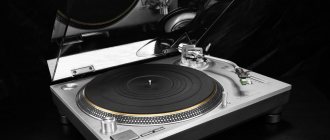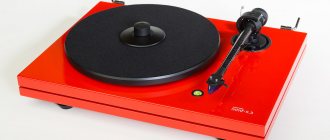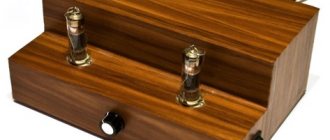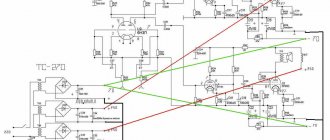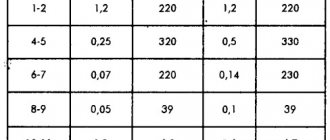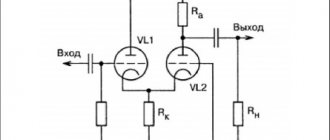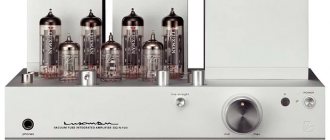- Hey Ya! I think you played in a band with Bassoi before? - Good evening. Yes, it happened. “He says you can make a tube amp for vinyl.” In the store the prices are steep and if you agree to make it not wildly expensive, then accept the order. - Suddenly. I will think.
So I set out to make a tube amplifier for a vinyl player, without having any experience working with vinyl.
↑ Non-tube phono stage on K548UN1
The turntable for which I needed to make an amplifier turned out to be a Pioneer PL333.
I picked up the documentation and realized that it only has one output directly from the electromagnetic head. No preamps or equalizers. One big “BUT” is that the output of the electromagnetic head is 5 mV and no matter what I do, this level will not be enough to drive the preliminary stage on the 6N2P. You need a preamplifier/phono preamplifier, but which one and on what elements? Heated discussions began again with the customer regarding the introduction of at least a couple more lamps into the circuit, which would increase the cost.
As a result, we agreed on the preamplifier on the microcircuit. Yes, yes, I know, it sounds strange - a microcircuit in a tube amplifier. There is no need to come up with something new in the field of pre-amplification of the signal from the electromagnetic head, because there is the good old Soviet classic - the K548UN1 microcircuit, which was in Radiotekhnika, Melodiya, etc.
The microcircuit is powered from +12 V using the L7812 stabilizer in a standard switching circuit.
How to choose an amplifier
Amplifier - how much there is in this word for a connoisseur of High-End equipment, and how little for a person who is coming face to face with the problem of choosing it for the first time. How many years have we been misled by advertising of mediocre equipment and music centers, saying that only power matters. Colorful stickers from the front panels of equipment from electronics supermarkets with wildly large power numbers shouted: “take me, I’m more powerful, louder and therefore better than the rest.” Time has passed, but in the minds of many people, power has remained the main criterion for choosing an amplifier, despite all their diversity and colossal differences among themselves. Well, how could it be otherwise? - you ask, - after all, there was simply no other information, and such technology was not publicly available. Yes, I probably agree, but it’s time to keep up with the times and correct old mistakes. Get ready, because right now everything secret will become clear.
If you are interested in High-End, then right now forget about “amplifiers” built into the same case with a CD player (or anything else). A high-end amplifier is a separate device with its own clearly defined functions. And also forget about hundreds of knobs, keys, and buttons that control incomprehensible settings that “improve” the sound for the worse. At the same time, forget about the equalizer, this is generally a fantasy in the High-End; by installing it in your device, the equipment developer obviously admits his worthlessness and invites you to correct your mistakes in the sound of the amplifier by turning a dozen knobs. I hasten to note that some semblance of an equalizer still exists in the High-End, but in the form of devices on DSP processors and it is used only in completely digital amplifiers. Remember again, only in completely digital amplifiers; in other cases, any semblance of equalizers is extremely detrimental to the sound, if its quality still matters to you. Digital amplifiers with DSP processors are such a delicate thing that we will consider them separately in the future.
So what functions does the amplifier perform, what settings can be found on it and what does it consist of?
So, first things first. A classic amplifier has only two main functions (classical in this context means analog, since we will look at digital amplifiers later in another section): signal amplification and switching of sources connected to it. By switching we mean that you can simultaneously connect many signal sources to the amplifier (CD players, vinyl record players, tuners, media servers, DVD players, SACD players, etc.) and easily switch the knob or press a button on the front panel select one of them to amplify the signal from it and transmit it to speaker systems. Yes, perhaps we can name one more function, this is amplification and RRIA correction of the signal from the head of the vinyl record player, but only if there is a phono preamplifier built into the amplifier.
Now about the settings. I’ll say right away that the better and higher quality the amplifier, the fewer settings it has, because it’s not without reason that they say: “improving something good only spoils it!”, because a High-End amplifier already has ideal settings and sound. To enjoy the ideal sound, it is enough to have only a volume control, an input selector (the same switch that selects one of the connected sources, made in the form of a rotary knob or a set of buttons), a “mute” button for instantly turning off the volume (while the amplifier continues to work, and the sound either not or it’s completely quiet) it’s useful if you urgently need to make it quieter, for example, if the phone is ringing and you need to answer, and the last thing, perhaps, is the balance knob for the left and right channels (especially useful if you choose a tube device, why we’ll look at it later). Although the last two options are also not necessary and you can completely do without them. I think that there will definitely be those who will object to me: “an ideally tuned amplifier is of course good, but why not give us the opportunity to choose ourselves and still add an equalizer or other settings to it, and we ourselves will decide whether to use them or not.” No". To this I will answer the following, everything that is between the live reproduction of music and our ears, including audio equipment, in one way or another worsens the sound of something from it by removing or adding something of its own that was previously absent in the original signal. So the task of High-End equipment is to reduce this signal degradation to the maximum possible minimum.
The source of music deterioration in equipment is all elements: transistors, lamps, resistors, rheostats, inductors, capacitors, etc. and each of them influences in its own way. Therefore, the task of the developer of High-End equipment is to reduce the number of these elements to the minimum possible quantity and at the same time select parts of the highest possible quality; this is not an easy task, hence the very high prices. The circuits of equalizers and other similar settings are quite complex and contain many of the above-mentioned elements, so even if you do not use the built-in equalizer of your amplifier, you are guaranteed its negative impact. If you remain unconvinced and still want to have it, then make sure that the amplifier has a switch that excludes, if necessary, the equalizer circuit and the general signal amplification circuit, although, I think, if you come to our Hi-Fi Profi and listen to the proposed components, you will understand that it is of no use to you.
What to choose, a single-block, double-block or three-block amplifier? Let's figure it out!
Now that we have figured out the functions and settings of amplifiers, it’s time to talk about what they consist of. Let's consider only the general features and the largest blocks, without going into technical details. A classic amplifier in the general understanding is a single-block (placed in one housing) device that amplifies a signal; in High-End equipment, the amplifier can consist of two or even three full-size devices (and sometimes more). But why? - you ask. To answer this question, let's look at the block diagram of the amplifier. In general terms, omitting the details, we can imagine the amplifier as a device consisting of three functional units:
1. Amplifier control (volume knobs, input selector, etc.) 2. Sequence of amplification stages 3. Power supply
If the control of the amplifier is not so interesting, then we will still consider the sequence of amplification stages. All amplifier stages are divided into three groups: 1) input stage, 2) output stage, 3) all others between the input and output. The input stage is one of the most important, firstly, it is a “buffer”, it matches the output impedance of the signal source and the input impedance of the amplifier (believe me, this is very important), and secondly, it works with extremely weak signals from the sources. As I wrote above, any radio components can degrade the sound and introduce distortion into it, but distortion introduced into such a weak signal as the one coming from the source to the input stage will ultimately be very noticeable, since they, like music, will be further amplified by the rest amplifier stages, so the best parts and ingenious circuits are used in the input stages. But not only radio components can degrade the sound, powerful transformers that cause vibrations and strong currents passing through the remaining amplification stages create electromagnetic fields that, according to the laws of physics, act on our ultra-sensitive input stage, causing “interference” and distortion into it. What to do? The designers and developers of the equipment asked themselves the same question and came to the general opinion that the input stage and controls should be moved outside the housing common with the other stages. This is how such a component of a High-End stereo system as a “preamplifier” appeared (in the best examples of preamplifiers, even the power supply is placed in a separate housing to prevent the negative influence of the electromagnetic field created by the transformer on the “delicate” circuits and weak signals of the preamplifier). What was not included in the preamplifier (intermediate stages and final stage) remained in a separate block and was called a “power amplifier” or “final amplifier”. Thus, the High-End amplifier became a two-block preamplifier + power amplifier, which immediately affected the quality for the better.
Maybe it would have been worth stopping at this, but the constant striving for perfection did not allow this. A little time passed and a lot of research and the power amplifier was divided into two “monoblocks”. A monoblock is a power amplifier that amplifies the signal of only one channel (either right or left), so for a stereo system you will need two of them. Well, why is this? - you ask. To answer this question, let’s turn to physiology (superficially), namely hearing. It is not for nothing that we are given two ears, based on the sound information entering each of them separately, the brain forms a spatial picture of the location of objects emitting sound, for this it analyzes the difference in the time of receipt of the same signal in each ear and the difference in the level (loudness) of the signals to determine the distance of objects. It is these effects that are used in sound recording so that two speakers can reproduce a wide sound stage that extends far beyond the boundaries of the speaker systems and the listening room. Simply put, if the sound comes from only one speaker system, for example the right one, and then gradually begins to appear in the left one, and on the contrary, fades away in the right one, then it will seem to you that the sound is moving around the room from right to left. From this we can conclude that if the signal of one channel penetrates into another, then the spatial effects conceived by the sound engineer and performer will be distorted during playback and perhaps this is what can prevent you from enjoying your favorite music to the fullest. When both amplification channels are enclosed in one housing, they involuntarily influence each other both through the same electromagnetic fields and through the common transformer from which they are powered. It was to eliminate this harmful effect that the power amplifier was divided into monoblocks, and it was not in vain that they did so.
Subtotal: Most manufacturers divide their amplifiers into three combinations:
1. Single-block amplifiers (also called complete or integrated) as the initial stage of High-End, suitable for the majority both in quality and price. 2. Two-block combinations of “preamplifier + power amplifier”, for enthusiasts in whose lives music occupies a large place. 3. Three-block combinations “preamp + two monoblocks” as Top High-End systems with uncompromising sound. These are flagships that are created using the best of the best engineers and only the best components. Note that I said “most manufacturers” for a reason, as this is just the most common “classification” for dividing an entire amplifier into separate parts in order to improve sound quality. Some manufacturers took a different path and moved the power supplies outside the amplifier, as the biggest source of interference, leaving the remaining components in one housing. There are so many options that you can’t count them all, so without the help of professionals from Hi-Fi Profi, you can make a mistake when choosing.
And now about the main thing, a three-block amplifier is not a guarantee of excellent sound quality, since its purchase imposes an obligation on you to select and purchase high-quality cables. By saving on cables, you will nullify all the efforts of the creator of the amplifier you purchased, and in the end you will only be left with the pride of having a perfect amplifier, but the listening pleasure will not be complete. We will also consider cables as separate full-fledged components of a stereo system in a separate section.
It should be noted that truly high-quality three-block designs are quite expensive and sound amazing, but if performed poorly, they will have more disadvantages than advantages. Therefore, when comparing single-block and three-block amplifiers of the same price category, a single-block full amplifier will sound many times better, since having the opportunity to save on an extra housing and power supply, cables and connectors, the developer can invest this money in higher quality parts, which will pay off with interest. So you shouldn’t chase a “three-block” if your budget is a little tight (high-quality monoblocks cannot be cheap), especially now, when there are real masterpieces among single-block integrated amplifiers. Well, if you have the desire and financial opportunity, then you shouldn’t save on your pleasure, because we only live once.
Now there are very interesting offers for those who want to get closer to the ideal, but cannot afford a full-fledged three-block amplifier - this is an integrated amplifier with the implementation of the “dual mono” principle. In this case, both amplification channels are placed in one housing, but they are completely isolated from each other and even use a separate transformer to power each channel and the preamplifier part. The same principle is used in some power amplifiers, so the choice of options is truly huge, let us help you decide. But all these are just words; the final choice must be made by your ears.
Size and weight matter, or a few words about the amplifier's power supply (for the curious) Power supply, no one has paid enough attention to it before. And indeed, remember all these chargers, power supplies, adapters, uninterruptible power supplies - all this is usually considered as something that allows the equipment itself to work, but is not its important component. And only now can we realize its full significance. The power supply is one of the most important components of any High-End component, starting from a record player, where a poor-quality power supply can lead to instability of the engine rotation speed, and therefore the disc with the record, which will be the main cause of detonation (this phenomenon will be discussed in the LP section - players) to powerful transistor monoblocks, where the cost of the power supply can reach 60% of the cost of the device itself.
As you may have guessed, the most important thing is the power supply in amplifiers. But why? To answer this question, it is necessary to consider the amplification process itself. As you know, energy does not appear from anywhere and does not disappear anywhere, but is only transformed from one type to another. The same statement is completely true for amplifiers. The amplified signal subsequently transmitted to the speaker systems is nothing more than “converted” energy supplied to the amplification stages from the electrical outlet familiar to us all through the same power supply. What does "transformed" mean? - you ask. I'll try to answer. So, such parts as transistors (in transistor amplifiers) and vacuum tubes (in tube amplifiers) are responsible for amplifying the signal in amplifiers; the principle of their operation is identical; Let's consider the simplest of them using the example of a conventional transistor. A transistor is an electronic device (part) that has three outputs: emitter (energy is supplied to this output from the amplifier power supply (direct current)), collector (from this output “converted” energy (amplified signal) is supplied to the next stage or to the speaker system ( if this is already the last stage)) and the base (a weak signal is supplied here, which needs to be amplified), which takes place between the emitter and collector. As you can see, direct current from the power supply is sent directly to the speaker systems, bypassing the transistor (through the “base” region), where it is “forced” to change with the audio frequency (i.e., as I already said, “converted”). The base to which the signal that needs to be amplified is connected is responsible for this very “conversion”. That is, it turns out that a weak signal supplied to the base controls the conversion of energy passing from the power supply to the speaker system. This is the process of signal amplification. A simple analogy will help you easily understand this complex process. Imagine a piece of pipe in the middle of which there is a valve and water flows through this pipe at a constant speed (this is current) and pressure (this is voltage). The pipe before the valve is the emitter, the pipe after the valve is the collector, and the valve itself is the base. If you periodically close and open the valve (base), then from the side of the collector pipe the water will flow either faster or slower, stronger or weaker. Just as you can control a large volume of water with a slight movement of your hand, a weak signal supplied to the base controls the energy coming from the amplifier’s power supply.
Now, I believe, you have no doubt that the power supply cannot be neglected and that it must be of high quality. But what is a high-quality power supply, what does it mean? Let's figure it out. The task of the power supply is to convert alternating current into direct current and reduce its voltage to the value required by the amplifier circuits. This means that the first quality parameter will be the quality of current rectification (conversion of alternating current into direct current, necessary for the amplifier circuits); rectifier circuits and smoothing capacitors in the power supply are responsible for this. After all, if a constant, poorly rectified current has some fluctuations, then they will be mixed with the sound signal and we will be able to hear them from the speaker systems along with the music. Well, this is a theory, in practice this is now difficult to find, since rectifiers are used almost everywhere. Much more interesting are other parameters, namely the power of the transformer and the total capacitance of the capacitors. Why? It's pretty simple. I think there is no need to talk about the power of the transformer, since it is clear that the greater it is, the greater the chance of satisfying the “requests” of the amplifier stages, especially the output stage as the main consumer. It is much more interesting to pay attention to the total capacitance of the power supply capacitors. This parameter is often indicated in magazine articles, but I’m sure not everyone knows why, so let’s find out.
Music consists of many frequencies and the reproduction of each of them requires a different amount of energy from the power supply, namely current. To be precise, the lower the frequency of the sound, the more current is required to reproduce it correctly. It was not for nothing that I highlighted the word “correct”, since all frequencies will be amplified and reproduced, but those for which there was not enough current will be sluggish and very different from real ones. Why am I saying this, but because the specific design and operating principle of the transformer impose some restrictions on the speed and volume of supply of the required current to the cascades. When playing complex musical moments (for example, very loud and especially low bass, such as a bass drum), the “supply” from the power supply will not be able to satisfy the “demand” from the transistors, the current will not have time to increase as quickly as required. It is here that we remember about capacitors, which, it turns out, not only smooth out the shortcomings of the rectifier, but also store energy for emergency musical moments. Thus, the transformer constantly charges the block of capacitors, and they, in turn, having the ability to instantly discharge, are able to deliver the required amount of energy directly to the emitters of the transistors at any time.
Conclusions:
1. The power supply should not be neglected for any component of the system, especially for amplifiers 2. If the equipment manufacturer offers to upgrade the power supply system of your component by purchasing an additional remote advanced power supply, then you need to take advantage of this and get maximum quality and pleasure 3. Power supplies are the only node of a High-End system where numbers can indicate quality 4. The greater the power of the transformer and the bank of capacitors, the better (there are rare exceptions)
So, we have reviewed brief information about the main types of power supplies (since there are also exotic switching and others), much written in this chapter touches on deeper topics such as the “relationship” between the amplifier and the speaker system, therefore, in order to form a complete understanding of the principles of building an ideal For high-end systems, I recommend reading sections of the site not selectively, but in a row, or even better, come to us and find out everything first-hand.
And yet, a transistor or a tube, that is the question. And what is better to choose a tube or transistor amplifier? Perhaps the disputes and battles between supporters of each of these technologies will never subside. Think about it, if one of these technologies had a significant advantage in everything over the other (including overall sound quality), would hundreds of manufacturers waste time improving a less promising technology that has a very vague future? The fact is that both the lamp and the transistor have their own advantages and disadvantages; to be more precise, they are each created for their own music and for their own listener. Simply put, advantages and disadvantages appear or do not appear depending on the music being played. An amplifier correctly selected for your musical tastes simply will not be able to show its weaknesses. You will probably now try to object: “What weaknesses can High-End have, after all, this is High-End after all!” I hasten to note that there are truly universal amplifiers for any music, but their prices are quite high. If you have an almost unlimited budget, then making a choice will not be difficult enough, buying the best of the best, but if your budget is a little tight, then we will be happy to help you make the right choice. A funny fact: the majority of people I interviewed who are not into high-end, but who have heard something about it, call tube devices examples of ideal sound. However, I will not refute or confirm these statements, because it is up to you to draw conclusions, and I will only help you find the right path to them. The biggest misconception and biggest mistake among high-end enthusiasts is the love of tube equipment just because it is tube. You need to listen to any High-End equipment and only then draw conclusions, because both among transistor products and among tube ones there are options that do not deserve attention from the audiophile community.
So, in order to figure out what is best for you, let’s first talk about the ideal. The first and most important thing is that an ideal amplifier (like any other component of the system) should not “sound”, only the music being reproduced should sound, and the amplifier itself should remain absolutely neutral and not leave its “sound imprint” on the music. It follows from this that ideal tube and transistor amplifiers should “sound” the same, that is, not “sound” at all. That is why it is extremely difficult even for real professionals to compare the most advanced and expensive high-end equipment with each other, since its “neutrality” is as close as possible to ideal values and it can be very difficult to catch the sound signature characteristic of each sample. Conversely, among more affordable equipment, differences will be noticeable not only between lamps and transistors, but also within these categories.
Let's first talk about the sound of music without technical details. Supporters of tube equipment call its indisputable advantage the warm and lively sound of music, the natural reproduction of high frequencies and timbres of musical instruments, beautiful vocals and stereo panorama. Yes, this is true, this is characteristic of lamps, but be careful, all these features should appear only where it is really needed, where it is recorded on a disk or record. If your entire music collection from classical music to Rammstein and Metallica, without exception, begins to sound soft and melodic, then this should alert you; this is a clear sign of a low-quality tube amplifier, an amplifier that leaves its obvious “sound imprint” on your favorite music and leads you away from its ideal playback With a high-quality amplifier, each musical direction and each individual performer can show their individual performance, but with a low-quality amplifier, all performers and styles are “combed” with the same brush and sound almost the same (this is also typical for low-quality transistor amplifiers). The disadvantages of tube equipment include some difficulties in reproducing low frequencies and bass, the complexity of the process of selecting speaker systems and additional maintenance costs. Lamps change their characteristics over time and need to be adjusted; over time, they fail and need to be replaced with new ones. But at the same time, the ability to install tubes from different manufacturers in your amplifier gives you the opportunity to endlessly experiment with sound. Fans of electronic and club music will experience difficulties with reproducing bass and low frequencies. I would like to note in advance that you should not despair, since this drawback can be minimized by careful selection of speaker systems (here you will not be able to do without the help of professionals from Hi-Fi Profi), mind you, it can be minimized, but not completely eliminated, since this is the specificity of tube technology. The bass of the tubes is more rounded and a little less harsh and sudden. This is less noticeable on acoustic drums than on electronic ones, which can sound a little sluggish and vague. This effect is due to the fact that the tube cannot provide the high currents required to properly reproduce low bass.
The main arguments of supporters of the transistor High-End are greater detail in music than that of lamps, powerful deep bass, the complete absence of time and money spent on servicing the device and an easier process of selecting speaker systems. But let's not rush to conclusions and figure it out in order. Of course, the detail of transistor amplifiers can be a little greater than that of tube amplifiers. But only a little more, here you also need to be careful when listening, since too high detail borders on such a dangerous phenomenon as “graininess” of the sound, the sound becomes caustic and harsh, including where it should not be. That is, as you can see, the situation with low-quality transistor amplifiers is exactly the opposite of what happens with low-quality tube devices with widespread excessive softness. To generalize, both lamps and transistors together go towards the ideal, towards the golden mean, only from different sides. When it comes to bass and low frequencies in general, transistor devices are the undisputed leaders (there are also decent tube units, but their prices are very high). But this is not a reason for everyone to give up tubes, this is just a signal for lovers of club or electronic music or simply music with a huge number of bass lines, but if you listen to classics, blues, soul and love vocals, then tube technology should definitely be on the list applicants for auditions. If we sum up the above, then there is no absolute ideal; each type of amplifier is ideal for certain music and this must be taken into account when choosing it. An ideal tube and transistor amplifiers “sound” the same, but they do not “sound” and remain neutral, that is, the higher the quality of the transistor and tube amplifiers, the more difficult it is to hear the difference between them when listening to them.
Still undecided on your choice? Still rushing between tubes and transistors? Is your music collection so diverse that it doesn't fit into one of the options? Then hybrid amplifiers were created just for you. A hybrid amplifier is a device that uses both tubes and transistors to get the best of both worlds. And as a more “advanced” version of the hybrid amplifier, this is a set of a tube preamplifier and a transistor power amplifier (or two monoblocks). This is, of course, not a panacea, since it requires a lot of experience to match one to the other, but with proper selection the result will be very good. Now is the time to approach the issue at hand from a technical point of view and at the same time find out why I mentioned tubes in the preamplifier, and transistors in the final amplifier. From a technical point of view, tube amplifiers look very imperfect, and their technical parameters are sometimes even ridiculous. Think for yourself what 15 Watt of an average tube single-ended amplifier is versus 1000 Watt transistor monoblocks. But don’t get your hopes up, not everything is as simple as it seems. Tube devices have an ace up their sleeve - their specific harmonic distortion. By the way, harmonic distortion is created by all amplification equipment (including transistor technology) and not only. “What is their specificity?” - you ask, because they are much more than for transistor ones, 1-5% for lamps versus 0.001-0.1% for transistor ones (the numbers are taken as statistical averages, since there are exceptions). In order to understand this, you first need to understand what harmonic distortion is. Without going into complex definitions, I’ll simply say that after amplification, additional frequencies appear in the signal that were not there before the amplification process, and they are multiples of the main frequency (there are also multiple intermodulation distortions, we are not considering them here, so as not to complicate the example). For example, when a signal is amplified at 1000 Hz (fundamental or first harmonic), the output will also contain 2000 Hz (second harmonic), 3000 Hz (third harmonic) and so on, only each next one sounds quieter than the previous one (although they are all quiet, they create an additional musical background, interfering with the perception of music as it is). So, for lamps, these harmonics end at the 3rd maximum 4th, and for transistors they extend up to the 7th, 9th, and sometimes further. Scientists have proven that low-order harmonics (1st, 2nd, 3rd, etc.) are worse perceived by the human ear (they are less audible, they are practically invisible to the ear) than higher-order harmonics (7th, 8th -i, etc.), even provided that in percentage terms the presence of lower harmonics will be tens of times greater than the higher ones. Simply put, for our hearing, 5% distortion at the first harmonics is much less noticeable than 0.1% distortion at the higher order harmonics. Conclusion: “tube” distortions are less noticeable to us than “transistor” distortions. This example is reliable when comparing ideal representatives of both types of amplifiers that are absolutely identical in all other parameters, but in practice exceptions can often occur. But nevertheless, this is the reason for the most frequent use of tubes in preamplifiers, since the signal in them is still weak and introducing harmful distortion into it is highly undesirable, and a tube preamplifier in this case is the lesser of two evils. And by the way, tube circuits are much simpler than similar transistor circuits, the signal path is shorter and there are fewer radio components along its path, which also reduces the risk of any additional distortion.
What you definitely can’t argue with is how difficult it is to choose a suitable speaker system for a tube amplifier. Why? It's simple! Approximately 90-95% of all acoustics are divided into two large groups: 4-ohm and 8-ohm. We remember from school physics that if the resistance drops, then the current should increase proportionally, with other things remaining constant. It turns out that for 4-ohm acoustics, in order for them to “swing” the same way as 8-ohm ones, twice as much current is required, which the vast majority of tube amplifiers cannot provide. Therefore, there are only two ways out, either refuse to listen to 4-ohm speaker models and concentrate on 8-ohm ones, or purchase a tube amplifier with an output transformer (which does not improve the sound) and terminals for connecting 4-ohm speakers (by the way, don’t forget , that the problem with the slightly “sluggish” bass described above still remains). Does the situation seem deadlocked? But no, here a transistor final amplifier will come to our aid, for which current is not a problem.
Well, we can consider this topic for a very long time, but we will probably focus on the most important thing that was described in this section. As you can see, there are a lot of options and without special training it is very difficult to make the right choice. Don’t risk your money and time, come to us at Hi-Fi Profi and let the professionals solve all your problems in designing the High-End stereo system of your dreams.
In our salon we are ready to offer you a comparative audition of both transistor and tube amplifiers. We stock transistor amplifiers from such brands as ARCAM, ATS, Audio Analogue, Audio Physic, AudioControl, Audionet, Bluenote, Boulder, Bryston, CEC, Cambridge Audio, Cary, Chord, Clearaudio, Copland, Cyrus, Denon, Densen, Electrocompaniet, Grado, Hegel, Holfi, Jeff Rowland, Marantz, Micromega, Musica, Nagra, North Star Design, NuForce, Onkyo, Ortofon, Primare, Rega, Roksan, Rotel, Simaudio, T+A, Wadia, Yamaha
As tube examples we are ready to offer Audio Note, Ayon Audio, Cary, Copland, Fatman, Herron Audio, Leben, Manley, Musica, Nagra, Nightingale, Pathos, PrimaLuna, T+A, Triode
↑ Nutrition
The anodes of the lamps are powered by an electronic choke using a field-effect transistor IRF830. I explained this scheme in my previous articles. The filaments of 6N2P and 6P14P lamps are powered from direct current through an adjustable stabilizer LD1084V with a load capacity of up to 5 A.
I have experimentally found that a 1K resistor (R20) is needed in the adjustment circuit in order to achieve an output voltage of 6.3 V under load (6.5 V at idle). At least 7 V AC must be supplied to the input of the diode bridge; for this I connected windings 11-12 and 15-16 in series.
What's the end result?
As usual, let’s summarize the basic principles of choosing a set of acoustics and options for connecting a vinyl record player.
Possible options:
- player with built-in phono stage → amplifier/receiver → passive speakers;
- player → external phono stage → amplifier/receiver → passive speakers;
- player → amplifier/receiver with built-in phono stage → passive speakers;
- player with built-in phono stage → active speakers;
- player → external phono stage → active speakers;
- player → active speakers with built-in phono stage.
The most flexible, of course, will be to use the phono stage as a separate device. You can upgrade the player as much as possible and buy absolutely fantastic acoustics, hitting the ceiling of your capabilities, but replacing the phono stage with a more advanced model will always allow you to continue upgrading the system. And choosing a specific model can give your kit a personal touch that you could never achieve with built-in solutions. But remember, no matter what we write for you here, the final choice is always yours.
Happy listening.
↑ Complete amplifier circuit
The general scheme is as follows.
There is a feature that I would like to draw your attention to. This use of grid resistors R33 and R35 (R49 and R51) rated 470 K can lead to self-heating of 6P14P lamps if they are old. When using fresh lamps, you don’t have to worry about this phenomenon, but if you are unsure of the quality factor, you should reduce the grid resistance to 330 K.
↑ Printed circuit board
The scheme worked immediately and did not require any configuration. But the fight against eddy currents and compensation currents deserves special attention. Here is a view of the printed circuit board.
There are two places on it with the caption “Possible minus switching.”
These are the points of convergence of the minuses of two power supplies - anode and filament. Connecting these two points together in different cases will give different results: both weakening and enhancing the background. I found a connection point on the body with a common signal minus, where there is the least background noise at the output. Afterwards, I tried to connect the marked points on the board one by one, so that there was no background at all. There is not enough space on the board for the radiators of the transistor of the electronic choke circuit and the adjustable stabilizer, so I used an L-shaped radiator.
The used output transformers TP-135-15-TV3-10 are adapted for printed circuit mounting and are located directly on the board.
After publishing the article “Multichannel 5.1 tube amplifier”, in which I used TP-135 transformers as output, they wrote to me several times that these transformers are very bad, but did not give any arguments. I would like to recommend the following technique to everyone who distributes diagnoses in absentia. Use a digital two-channel oscilloscope with the “math operations” option, connect to the primary and secondary windings of the transformer, adjust the attenuation in the primary circuit with a probe or additional resistance and use the “math” function to subtract one signal from the other. The output you will see is an almost perfectly straight line, both under static and dynamic load.
The distortions claimed by opponents were not found in the TP-135 transformer.
How does a vinyl record player work?
- The adapter fills the large center hole of older format records.
- The slipmat keeps the record from sliding on the platter. It can be felt or rubber, felt is more gentle.
- The platter, or platter , rotates to spin the record. For stability you need something heavier.
- The phono stage converts the signal for the line input; it is the link between the player and the amplifier.
- Speakers, headphones, and amplifier are connected to the outputs The more such connectors, the better.
- Anti-skating aligns the tonearm with the center of the groove.
- A counterweight regulates the clamping force so that the stylus does not press on the record and at the same time fits tightly into the groove.
- to the tonearm . For beginners, a tonearm with a factory setting is better.
- The cartridge with the stylus removes the sound from the record. There are MC and MM cartridges: MC is used for Hi-Fi systems (equipment that reproduces sound as close as possible to the original); MM is suitable for both listening and DJing. It is important that the cartridge is replaceable.
- The case protects the player's internal components and absorbs vibrations. It is better to take something heavier: from 4 kg.
- The speed switch is needed to play audio from a record at the speed indicated on it - 33 or 45 rpm.
↑ Two body layouts
It came to the hull. The customer had a torn Melodiya-103 stereo vinyl player that could not be repaired, and with a cockroach that had died inside. It was then that the idea came to me to use its body as a basis. I drew a layout of the elements inside the case.
In the rear part there are two power transformers TN-56 and TA-199, shielded from the outputs and the main board.
Opposite them are all the hanging elements associated with the mains power - the power and fuse sockets, the switch. The preamplifier and preamplifier power supply boards are mounted on the left side. The input is located on the front panel. Showed it to the customer. — No, no, I need all the switching at the back, both the outputs and the input. Otherwise everything is fine. “But this is fraught with problems in the form of leads.” - Well, is it possible to do something about this? — It can be shielded, but these are additional problems.
The new and final layout of the elements looked like this.
The outputs are located on the rear panel above the input.
I started to implement the housing layout. I took the empty case from Melodiya-103 from the customer, disassembled it into parts, and threw away the excess. I sawed off the back and front panels to the customer's dimensions. Put it together, it turned out to be a rectangle consisting only of the back, front panels and side walls. The bottom cover of the original “Melody-103” is made of chipboard and is full of technological holes, this does not suit me and it goes to the trash. I decided to make the new bottom cover from laminate, it is much stronger.
For shielding purposes, I glued the bottom with metallized tape, having previously coated it with superglue for reliability. For strength, I tied the side walls together with three fastening sheets, onto which I installed 4 pins for fastening the main board. I drilled holes for the hanging elements and sanded everything down with primer sandpaper.
Primed.
The first primer showed all the surface imperfections that had not been eliminated.
I had to more carefully sand the surface and sand it with a sanding cloth. I primed it a second time. Everything turned out well. In place of the supposed entrance on the rear panel, a tinned piece of PCB was soldered onto which the screen will be sealed.
I also decided to make the input socket screen from PCB. I cut the blanks, tinned them on the inside and soldered everything together.
I drilled a hole for the wire and tinned the back wall. It was supposed to use a shielded wire, and the screen was tightly soldered around the outlet hole. I painted the body with matte black paint and installed power transformers.
I screwed on the top cover fasteners. They were made from furniture corners, onto which a washer and a nut with a diameter of 4 mm were sealed using soldering acid. For best symmetry above the hole, before soldering, secure the washer and nut to the angle using a bolt. You just have to be careful when soldering so as not to solder the bolt too. After the corner has cooled, the bolt is unscrewed.
I secured the preamplifier and preamplifier power supply to the case.
I covered the preamplifier board with a screen.
I installed a separating screen between the power transformers and the main board. I installed the board on the pins and secured all the missing fittings for the front and rear panels. Conducted installation of wires.
In this form I took it to the customer for a preliminary audition. - Everything sounds cool. - Exactly? - Exactly, finish the top cover and bring it back completely.
The top cover was made of metal. The power transformers are higher than the main body, so I thought about the threshold.
The piece of metal was not the first freshness, and it took some effort to remove all the rust from it. Afterwards I primed and painted. The holes for the sockets were initially drilled with a 16 mm drill and then drilled out with a dental drill to a diameter of 20 mm. I printed my label on photo paper, cut it out and glued it to the top cover with superglue.
Description
Playing music on a vinyl device gives high-quality sound, takes you back to the past, and creates a unique atmosphere for any style. Speakers for vinyl are distinguished by high transmission of pure sound, ideally conveying the density and airiness of the recording.
Types depending on the presence of a stereo amplifier:
- Passive. This type implies the presence of special stands and a stereo amplifier for maximum sound transmission. There are also combined models, but very rarely.
- Active. They do not require an amplifier to operate, just the sound source itself and 2 speakers. All the necessary equipment is located inside the speakers.
Types depending on location:
- Floor-standing. They are installed directly on the floor, provide surround sound, but are not recommended for use in rooms smaller than 17 sq.m.
- Shelf. They are installed on shelves (on a table, stands, etc.), or on special racks. There are also models that provide for hanging the system on the wall (there is a special hole at the back for a screw). An inexpensive option, but it will not provide such surround sound as a floor-standing one, and there will also be less bass.
The best manufacturers
Let's consider the most famous manufacturers on the world market:
- Yamaha. A Japanese company operating on the market since 1887, constantly improving its products. It produces equipment for both the budget segment for home use and for professionals.
- ELAC Solano. A German company with many years of tradition in high-quality and inexpensive production of various equipment. Founded in 1926.
- Advance Acoustic. The French manufacturer has been on the market since 1995, with the central office located in Paris. For them, the quality of the product comes first; this criterion has made the company a leader in the production of musical equipment of various types.
- Monitor Audio. The British company is a leader in the production of hi-fi speaker systems used in stereo systems and multi-channel surround sound systems.
- Sony. The Japanese company was founded in 1946 and produces various high-performance equipment. Famous brand in many countries. Their products are in great demand, they have an acceptable cost and durability.
